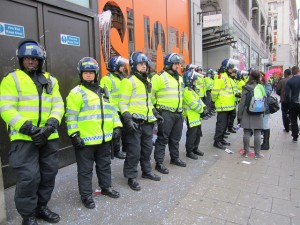Social Media, the Riots and a Different New York Approach
 British papers are full of news stories and commentary about the role social media has played in the riots that rocked London and other major cities.
British papers are full of news stories and commentary about the role social media has played in the riots that rocked London and other major cities.
Prime Minister David Cameron’s calls to shut down some sites have been met with a barrage of criticism, such as this op-ed in the Guardian. Others have attacked the government’s overall response, including its attack on social media outlets and the deployment of water cannons comparing the aggressive behavior to the Mubarak regime’s initial response to the Egyptian uprising.
The Telegraph has a stream of comments on its web site, some from former police officers, critical of the police for not being aggressive enough, including their hesitation in shutting down the Blackberry and other cellular networks. The Blackberry network was reportedly instrumental in maintaining anonymity for many protestors and organizing riots.
For a balanced view of the role of social media during England’s worst outbreak of domestic violence in decades, see this post by London-based journalist Adam Westbrook.
Meanwhile, back in the United States, the police seem to be using social media to get ahead of any evil intentions.
A new juvenile justice unit of the New York Police Department is using the same social media tools — mostly Twitter, MySpace and Facebook — to discover and track troublesome house parties, gang showdowns and other potential mayhem, according to an article on NYDailyNews.com.
Under Police Commissioner Raymond Kelly, the NYPD has already used technology to help solve a number of juvenile cases, including an anti-gay attack at a house party and a shooting at a reunion that went viral on Twitter. He instructs all police commanders to keep track of house parties, especially those advertising online.
In June, JJIE reported on an incident in Boston involving police who used social media to track teens, but mislabeled groups as gangs. The media jumped on the story and the “gang violence” spread quickly. As articles were published, teens with knowledge of the gatherings disagreed with them.
One user wrote as a comment to a news article, “it was no gang fight, I was there.” Others made similar remarks.
Photo credit: mastermaq on Flickr.
Newsfeed Archives
- November 2024
- October 2022
- June 2022
- May 2022
- February 2022
- January 2022
- December 2021
- November 2021
- August 2021
- July 2021
- May 2021
- April 2021
- February 2021
- January 2021
- December 2020
- October 2020
- August 2019
- August 2018
- May 2016
- September 2014
- April 2014
- December 2013
- April 2013
- August 2011
- July 2011
elsewhere
- An interview with Karlan Sick, Board President
- BOOKS CAN HELP INCARCERATED TEENS SUCCEED
- Books Through Bars
- Distribution to Underserved Communities Library Program
- Juvenile Justice Information Exchange
- Life Lessons Through Literacy for Incarcerated Teens
- Passages Academy Libraries
- Passages Academy Schools
- Read This
- What's Good in the Library?
- Women and Prison




